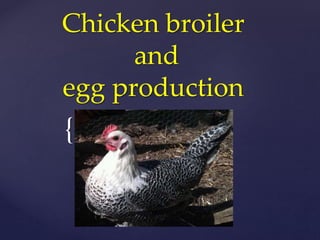This document provides information on chicken broiler and egg production in the Philippines. It discusses selecting chicken breeds, housing requirements, common diseases, and feeding management. The key points covered are guidelines for selecting foundation stocks, housing specifications based on stock type and production capacity, symptoms and prevention of common poultry diseases like Newcastle disease and fowl pox, and feeding recommendations for broiler and layer chickens at different growth stages.





































